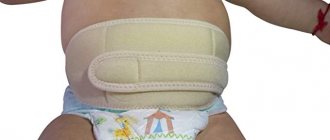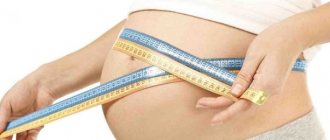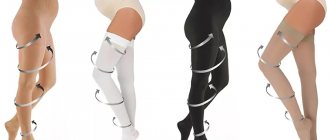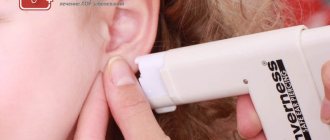From when to wear a bandage for pregnant women?
During pregnancy, many women are prescribed by doctors to wear a bandage. This is a type of medical product that is usually made in the form of a specially shaped corset or a wide belt. The purpose of such products is to support the abdomen, which contributes to a healthier pregnancy, reduces stress on the back and pain, and also prevents the formation of stretch marks. The product is prescribed only for medical reasons. An important point is the correct choice of the gestation period from which to start using the product.
When to start wearing a brace during pregnancy
General recommendations for the use of this product are given by your attending physician. He also determines from what month to wear a bandage for pregnant women. When determining this period, a whole range of factors must be taken into account.
Here we will display the goods
As a rule, wearing a belt is recommended from about 4-5 months of pregnancy. By this time, the stomach is already quite enlarged. The signal to start using the belt is increased loads, which become difficult to cope with on your own. Until the 20th week, many doctors do not advise wearing an orthopedic bandage unless there are specific medical indications for this.
The question of which week to wear a bandage for pregnant women is decided individually for the following conditions:
- multiple pregnancy;
- a scar as a result of previous surgery on the uterus;
- Excessive amount of amniotic fluid.
In such cases, wearing a belt from the 16th week can reduce the possibility of complications. Mandatory medical indications also include abnormal enlargement of the fetus or uterus, too low a placenta, as well as the threat of unplanned termination of pregnancy. Possible contraindications must also be taken into account. The main one is the incorrect position of the fetus inside the uterus.
If the abdominal muscles are well developed, there is no need to wear a belt in the early stages. If you are not worried about discomfort and pain in the lumbar region, a support belt is prescribed from about 28 weeks. However, these recommendations, from what stage of pregnancy the bandage is worn, are valid only when carrying the first child. During the second and subsequent pregnancies, a stronger stretching of the abdominal wall is observed, so it is recommended to wear a bandage already when a noticeable belly appears.
Wearing mode
In addition to correctly determining the period from which you need to put on the bandage, you must also follow the regime of its use recommended by your doctor. You cannot wear the belt 24/7. The product must be removed at night, as well as during daytime sleep. During the day, the bandage should be removed every 2-3 hours. The duration of such breaks in wearing should be 30-40 minutes.
From the 38th week of gestation, the use of the bandage is limited to the maximum. During this period, the expectant mother’s body is actively preparing for the birth of a child. The stomach begins to gradually drop. Additional support can already be harmful. Therefore, the bandage should only be worn during strenuous activities, for example, before doing any work at home or before long walks. However, it should be borne in mind that this recommendation is only valid in cases where there are no specific indications. For example, if a bandage was recommended based on the increased risk of early miscarriage, then it should be worn almost until the last days of pregnancy.
Types of bandages
The main types of bandages are listed below.
1. Prenatal (bandage for pregnant women) and postnatal. The bandage for pregnant women looks like a wide belt with Velcro, its back part is located in the sacrum and lumbar region, the front part clasps and supports the abdomen. The product relieves stress from the muscles of the spine and abdominals, prevents back pain, eliminates uterine hypertonicity, which has a beneficial effect on a woman’s well-being and the course of pregnancy. The postpartum bandage is also an elastic belt, but the purposes of its use are different. It promotes a speedy return to shape after childbirth and cesarean section, the return of organs to the correct position, and the restoration of the previous waist size.
2. Hernia bandage. A children's bandage for the treatment of umbilical hernias is a thin belt; an adult product may look like a corset, resemble shorts or panties (depending on the purpose of use). Hernia bandages keep the hernia in a reduced state, prevent it from being strangulated, do not allow the disease to progress, and wearing them constantly helps to avoid surgery.
3. Postoperative bandage. A wide belt or “corset”, the fasteners are usually located in the lower chest area. Designed for rapid healing of surgical wounds, prevents the development of a hernia in the scar area, and reduces pain after surgery.
4. Bandage for children. Bandages for children are most often used for the treatment and prevention of umbilical hernias, and are sometimes used after operations. They are placed in a separate group, since they are made from special elastic materials and have a number of features that make it possible to use them in children.
General approaches
The bandage should be selected individually. It is better to purchase it for yourself, and not to take it blindly from someone. After all, even if women have the same height and hip circumference, the configuration of the pelvis and the shape of the abdomen may differ. And a belt that fits one pregnant woman perfectly may not be comfortable for her friend. In addition, using someone else's wearable device is unhygienic.
Not all pregnant women wear a special belt every day, coping without it. In addition, it is uncomfortable and sometimes even undesirable when a woman works sedentarily. But if during the day you expect a long walk, going up and down stairs, or standing for a long time, it is better to resort to using a bandage. This will reduce the risk of developing back pain, swelling in the legs and uterine hypertonicity.
A bandage that is not placed correctly on the body can cause discomfort or even harm. Undesirable consequences may include disturbances in the blood supply to the legs and pelvic organs, tightness of the baby in the mother’s stomach and increased tone of the uterus. Therefore, when using it, you should follow some rules.
Contraindications
In addition to the indications for using the bandage, there are also a number of contraindications for which it should not be worn:
- Diseases of the gastrointestinal tract, in particular gastric ulcers, in which squeezing organs is strictly prohibited.
- Dermatological diseases, presumably localized at the point of contact of the bandage with the skin.
- People with kidney failure and other kidney diseases that cause swelling should not wear a bandage.
- Fresh postoperative sutures and scars. You should not wear a bandage immediately after surgery. Only a doctor can decide how long after surgery you can start wearing a bandage.
- An allergic reaction to the material from which the product was made.
- It is not recommended to buy a postpartum bandage product in advance during pregnancy, since after giving birth the woman will definitely lose weight, and the size of the bandage should correspond exactly to the actual volume of the hips.
Indications for use
There are several indications for which a doctor may prescribe wearing a bandage:
- Surgery to remove the uterus, hernia, or caesarean section.
- Hernia. A bandage is prescribed for excessive physical exertion, despite the presence of a hernia, and also if wearing a bandage will help avoid surgery.
- Varicose veins, accompanied by severe pain.
- Multiple difficult pregnancy or threatened miscarriage.
- Prevention of back pain and the development of an umbilical or inguinal hernia during heavy physical activity.
What it is
Bandage - what is it? This is an elastic belt with fasteners or Velcro that securely fixes the necessary organ. When wearing a bandage, the patient begins to experience relief, which contributes to a faster recovery. Thanks to its elasticity, wearing a bandage helps reduce the load on the spine, prevents pain in the lumbar region and reduces the feeling of heaviness in the body during physical fatigue.
Forms
What it is - a bandage and what types exist, it became clear. The shapes of bandage products are also distinguished by their diversity:
- To support the lower back, a bandage in the form of a tape or belt is usually prescribed. This product is convenient for pregnant women to use, since it is usually fixed under the stomach and does not put pressure on the uterus.
- Bandage in the form of panties. Effective for reduced hernia, helps maintain it in the correct position, preventing it from being strangulated. It is often prescribed after surgery to remove a hernia or after childbirth.
- Combination. Such a bandage effectively and evenly distributes the load throughout the body. Prescribed during pregnancy to strengthen the back and for pain in the spine.
- Grace. Bandage in the form of a corset with fasteners located in the side and bottom parts of the product.
How to put it on correctly
The bandage must be worn correctly. Although in the instructions for some models you can read a phrase about the possibility of putting it on while standing, it is still better to do it while lying down. In an upright position, the pregnant uterus tilts slightly forward and moves downward under the force of gravity. At the same time, the stomach protrudes more strongly, because the overstretched abdominal muscles can no longer fully hold it.
If you put on a bandage in this position (standing), it will not provide adequate support, and you will feel a feeling of tightness and pressure on the abdomen due to incorrect wearing. Located just below the recommended level, the bandage often compresses the neurovascular bundle in the groin area. This can lead to swelling in the legs and cramps in them due to impaired venous outflow and lymphostasis.
It is recommended to put on the bandage while lying on your back, on a fairly hard surface. This will allow the lower back to take a physiologically correct position, and it will also be easier to determine the bony landmarks for the location of this supporting device on the body.
The bandage can be attached soon after waking up without getting out of bed. During the day, you can use a bouncy sofa, couch, or even the floor. In this case, you need to lie down for 10–15 minutes so that the muscles relax and the uterus changes its position. The child will rise a little higher. In this case, the worn bandage will not press the fetal head and will not allow the baby to put pressure on the cervix.
The bandage belt is worn on underwear or thin clothing made from natural fabrics. At the same time, you should consider going to the toilet so that you don’t have to remove everything in a cramped stall. But panties can be worn on the body or on underwear; they have fasteners at the bottom.
How to wear
Often, in his instructions for wearing a bandage, the doctor recommends wearing it constantly without removing it. However, the period of wearing the product can be four months or more; when the desired result is achieved, it can be removed.
It is also important to remember that the bandage must be removed at night, since the organs should rest at this time without any external pressure.
Wearing a bandage after surgery should alternate with moderate physical activity, that is, performing exercises from a physical therapy program.
Wearing a prenatal bandage should begin from the fourth month of pregnancy until delivery. During pregnancy, you need to put on the product in a supine position, this is how the stomach takes the most correct position.
The postpartum bandage should be worn for at least two months, but you need to take a break of 2-5 hours a day. Wearing a postpartum bandage should be combined with physical activity.
If rashes, redness or itching appear on the skin where the product comes into contact with the skin, it is better to remove the bandage and consult whether it can be worn in this case and what measures to take to avoid health problems.










